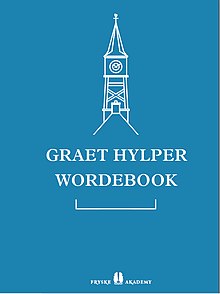Hindeloopen Frisian
You can help expand this article with text translated from the corresponding article in Western Frisian. Click [show] for important translation instructions.
|
| Hindeloopen Frisian | |
|---|---|
| Hindeloopen–Molkwerum Frisian | |
| Hylpers | |
| Native to | Netherlands |
| Ethnicity | Frisians |
| Language codes | |
| ISO 639-3 | None (mis) |
| Glottolog | hind1273 |
 Hindeloopen Frisian is classified as Critically Endangered by the UNESCO Atlas of the World's Languages in Danger | |

Hindeloopen Frisian (natively Hylpers, West Frisian: Hylpersk, also referred to as Hindeloopers in English and Dutch) is a West Frisian variety spoken in the port town of Hindeloopen and the village of Molkwerum on the west coast of Friesland. It has preserved much of the Old Frisian phonology and lexicon, and has been attested to since the 17th Century. Hindelooper is spoken by some 500 people in Hindeloopen, almost all of them elderly, with the number of speakers decreasing.[1]
Recognition
[edit]In 1981, the Fryske Akademy (Frisian Academy) published a dictionary of the language (then seen as a dialect) entitled Hylper Wurdboek.[2] In 2006, work began on a successor to the dictionary, which was published in 2019 under the name Graet Hylper Wordebook. Authors of the new edition included Gosse Blom and Sybrek Dyk.[3] The newdictionary contains 1000 pages of words, grammar and synonyms and is considered the definitive version of the language.[4]
In 2019, Glottolog assigned the language the code "hind1273", under the name "Hindeloopen-Molkwerum Frisian".[5] Language activist Dyami Millarson, responsible for the Glottolog entries of both Hinderloopers and Terschelling Frisian stated that "these 3 languages have a complete language system, it's not just a few words which are different from Frisian, the languages have developed separately from Frisian. Hylpers and Frisian are more different from each other than Afrikaans and Dutch" in an interview with Trouw regarding the dialect.[6]
The Hylper language is taught at the local elementary school. [citation needed]
Development
[edit]Due to its position on a peninsula, Hindeloopen was very isolated from the mainland until the 20th century and for centuries had more contact with the coastal cities in Holland on the other side of the South Sea. Because of this, Hindeloopen Frisian underwent greater influence from Hollandic speech than the other dialects of West Frisian. The location of Hindeloopen is, however, not a complete explanation for the dialect: until about 1800, Koudum had a dialect that was very similar to Hindeloopen.
Differences compared to Standard West Frisian
[edit]- In Hindeloopen Frisian, the l in the trigraphs âld and âlt is pronounced, as in Standard West Frisian, and is subject to vowel lengthening.
- The Standard West Frisian tsj is reduced to tj or s; for example, tjian for the standard tsjin (against) and serke for the standard tsjerke (church).
- The digraph ae is still used instead of the modern aa.
- The standard ú is written uu.
- Non-standard letters used: ä, ö, è and ò.
There are also a few lexical differences, such as siie instead of naaie (to sew), tät instead of happe (a child’s word for “horse”) and öie instead of sipel (onion). The dialect’s vocabulary preserves many more words from Old Frisian that are no longer used elsewhere. The differences in pronunciation and vocabulary between Hindeloopen Frisian and Standard West Frisian are so big that mutual intelligibility is difficult. However, Hindeloopen Frisian has gradually become more like standard West Frisian due to increasing contact with speakers of other dialects. [citation needed]
Example
[edit]| The Fisherman and His Wife | |
|---|---|
| Op in dei siet er sa wer ris mei de angel yn 'e hân yn it heldere wetter te stoarjen. Hy siet mar en hy siet mar. Doe bûgde de angel hiel djip troch. Doe't er ophelle, kaam der in grutte fisk út it wetter, in bot. De bot sei tsjin him: "Hark ris, fisker, ik freegje dy om my libje te litten. Eins bin ik net in bot, mar in betsjoende prins. Wat hast deroan ast my deamakkest? Ik smeitsje dochs net. Set my mar wer út yn 't wetter en lit my swimme." | Op in dei seet er só wur ris te fiskjen, en sooch er geduerich yn it heldere wetter. Hy seet mar en hy seet mar. Dê geeng de dobber nei ûnderen, de dêpte yn, en dê't er ophelle, hee er in helen graeten bót oen 'e hook. De bót see tjian him: "Hear ris, fisker, yk smeak jy, leet my libjen bliuwe. Eigenlik bin yk gin bót, mar in betjoenden preans. Het hest deroen ast my daamekkest? Yk smeikje dochs naat. Sot my weróm yn it wetter en leet my swemme." |
References
[edit]- ^ "Eerste exemplaren Graet Hylper Wordebook vrijdag officieel overhandigd". www.omropfryslan.nl (in Dutch). 2019-03-29. Retrieved 2022-12-28.
- ^ Blom, Gosse (1981). Hylper wurdboek (in Western Frisian). Fryske Akademy. ISBN 978-90-6171-605-1.
- ^ "Graet Hylper Wordebook verschenen". Fryske Akademy (in Dutch). Retrieved 2022-12-28.
- ^ "Friesch Dagblad". Friesch Dagblad (in Dutch). Retrieved 2022-12-28.
- ^ "Glottolog 4.7 - Hindeloopen-Molkwerum Frisian". glottolog.org. Retrieved 2022-12-28.
- ^ "Spreekt u al Aasters, Schiermonnikoogs of Hielpes? Dankzij Dyami Millarson (25) zijn het nu zelfstandige talen" Dutch, Trouw, 2 juni 2019
